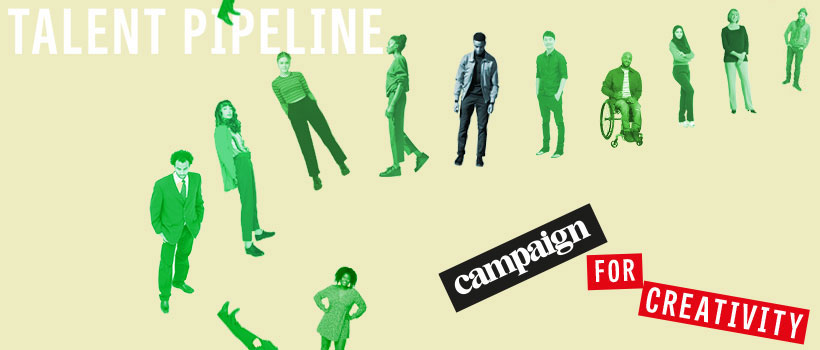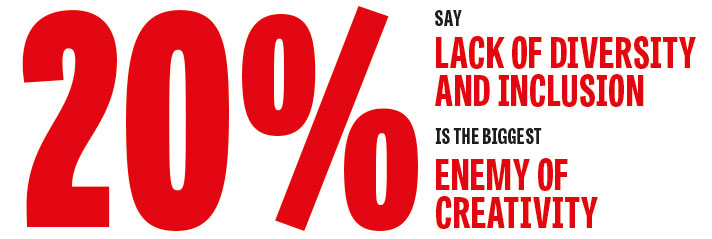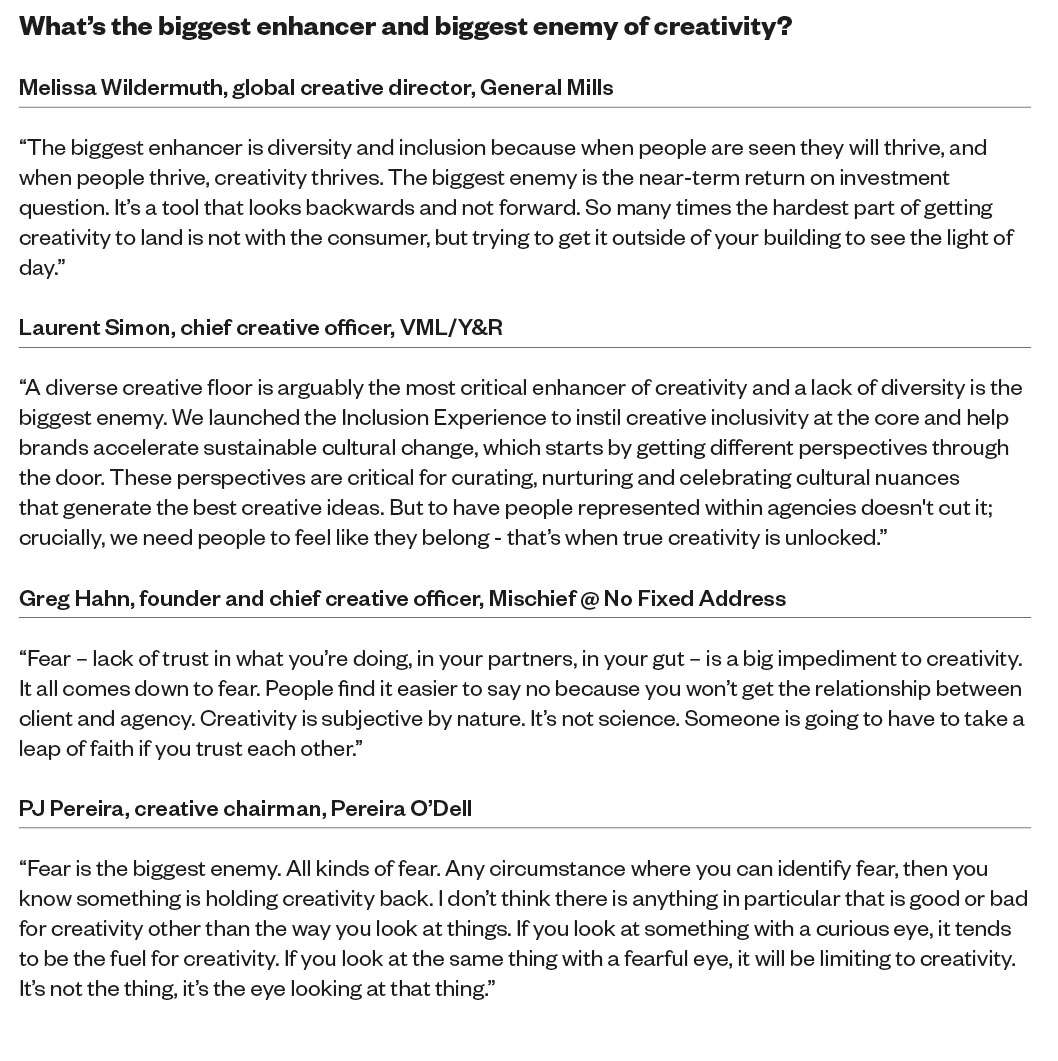
Talent is key to creativity yet the advertising industry has struggled to charge a premium for some of its services, leading to a culture of low fees, sometimes modest pay and high employee churn – despite global ad expenditure growing strongly over the past decade.
Diversity, equity and inclusion (DEI) has become a particular area of concern because there is a growing recognition, reinforced by recent census surveys from the World Federation of Advertisers and the UK industry’s All In, that adland’s workforce does not reflect wider society.

When Campaign surveyed more than 1,200 industry executives around the world, 20% cited the talent pipeline and the lack of diversity and inclusion as the biggest “enemy of creativity” – second only to profit and performance targets (38%) and the dominance of technology (24%).
This feature is the second instalment in a three-part editorial series that focuses on three key issues affecting the global advertising industry – profit versus purpose, the talent pipeline and the dominance of technology – and examines both the “enhancers” and “enemies” of creativity.
Read part one: Profit vs purpose: advertising’s global balancing act
Campaign’s editorial teams in the UK, US and Asia have teamed up as part of a new initiative, “Campaign for creativity”, which champions the magazine’s belief in the importance of creativity “to inspire people, build brands, drive innovation and transform lives”.
The series is running on three consecutive days ahead of this month’s Cannes Lions – the biggest annual gathering of the global ad industry and the first in-person version of the festival since before the pandemic.
Campaign has an unrivalled international network of websites and journalists in eight key markets – Asia, China, India, Japan, the Middle East, Turkey, the UK and the US – and “Campaign for creativity” emphasises our shared commitment to champion creativity and to hold the ad industry to account.

“Lack of representation has an impact on creativity”
The view from Campaign UK
By Nicola Merrifield, premium content editor
When the results of the World Federation of Advertisers’ first global census, tracking diversity in the advertising workforce, landed last year, its organisers pointed out not only the impact on individuals but on creativity too.
The research showed “that for many individuals the marketing industry is not as inclusive nor as welcoming a place as we know it needs to be”, according to Jerry Daykin, global diversity ambassador for the World Federation of Advertisers, which co-ordinated the survey of more than 10,300 people across 27 countries.
“Through some of our wider work with the WFA we’ve been exploring the power of representative creative output and we know that that starts by listening to representative voices and having diverse opinions from our teams,” Daykin, who is vice-president, head of global media at Beam Suntory, said at the time.
A lack of diversity and inclusion has been on the ad sector’s radar for some time. But the problem is being felt more keenly now because it’s being linked to the wider issue of a depleting pool of talent – and, crucially, at a time when the sector is back in growth mode and projected adspend continues to be higher than pre-pandemic levels.
In the UK, the Advertising Association has recognised the problem is so challenging that it has launched a “Talent Taskforce” to uncover the key reasons why staff are leaving.
Announcing the initiative in January, Alessandra Bellini, the president of the AA and chief customer officer at Tesco, said: “From the moment I joined the association last autumn, talent retention has come up time and time again as a common challenge we are all facing.”
Early indications from the AA’s work show diversity is one of the three key areas – along with slow salary growth and increasing skills requirements – that need to be tackled to stop staff moving on, according to an update Bellini gave at Campaign’s Media 360 event in Brighton in May.
“We feel there is a problem with representation, inclusion and diversity in the industry – are we truly, truly representing the country and the potential of the talent that we have in all parts of society?” Bellini told media and agency professionals.
A broad range of issues needs addressing but, according to the WFA’s 2021 global census, the two most common reasons for discrimination at work are staff age and “family status” – meaning providing care for children, older or sick relatives. A total of 36% of respondents agreed age could hinder careers at their company, and 27% said their employer did not treat all staff equally regardless of family status, with women affected the most.
Certain European countries had some of the worst results for age discrimination among 27 markets surveyed globally: Ireland (45% said age was a barrier), Spain (44%) and France (43%).
Meanwhile, in the UK, the sector carried out its own All In census earlier on in 2021 among 16,000 ad professionals, concluding that urgent action was needed to boost representation of black, disabled and working-class talent.

Lack of representation has an impact on creativity
As DE&I has risen up the agenda, there is a growing awareness that lack of diversity and representation can lead to a “killer” situation for creative departments. Agencies and brands that do not have a diverse workforce are less likely to come up with creative concepts, characters and stories in ads that are distinct and fully represent the range of their customers.
Laura Jordan Bambach, president and chief creative officer at Grey London, says: “The cultural consensus that comes through not having a diverse creative workforce has always shown itself in ideas that all come from the same shallow creative pool. In an industry that relies on standing out, and where blending into the background is detrimental to the business needs of clients, it can be a killer.”
As a result, the agency has built diversity into its policies across the company, plus new remote ways of working allow for more recruitment from outside London, she adds.
Jane Evans, an executive creative director who has worked in London and Australia, is founder of The Uninvisibility Project agency and movement, which is designed to promote careers for midlife women in the ad sector. Women “disappear” from creative departments after the age of 30, she says, due to fewer opportunities for promotion and the difficulties of juggling a career with family responsibilities.
Creative teams are therefore “completely missing out” on ideas relevant to older women. This applies “particularly to women aged 45 plus – they buy 50% of everything and yet we are a rarity in creative departments”, Evans says.
Mental health is another key factor that is affecting talent in the advertising industry. Around a third of WFA census respondents said they felt anxious at work, which risks creating a domino effect of even more employees – especially those from diverse backgrounds – and their ideas being lost.
The UK’s All In census backs this up: black staff most commonly said they were likely to leave the industry altogether due to a lack of inclusion (32%), followed by Asian (27%) and mixed race (19%) employees. This compares with just 10% of white staff.
Making advertising a more attractive industry for all
Adam & Eve/DDB’s head of diversity, equity and inclusion, Bukola Garry, says: “More needs to be done in terms of how we brand our industry in attractive ways for [people across] different types of representation. While there is a lot of good work being done, it is ad hoc and disparate.”
The agency business model is also not helping, she adds: “We are funded by clients and so we have to work in partnership with our clients to be able to fund and resource the ability to find representation. The talent is out there, but the cost of living has gone up and salaries have gone up, but if the fees aren’t going up then we are stuck.”
Some creative teams are more optimistic about the talent crunch, and say it will force agencies and brands to hire more diverse staff that are, in addition, given more opportunities to come up with ideas that break stereotypes.
Andy Jex, chief creative officer of TBWA\London, says: “You have to look at this as an opportunity. If you’re an agency that is not going to challenge and is not willing to change, that is a massive problem. If you’re willing to bring people in, nurture them, give them the freedom, flexibility and lifestyle they want, then you will open yourself up to a pool of people that the industry has had a hard time attracting.”
Ultimately, Jex warns that unless the sector improves its hiring and retention of a broader workforce, including those who may not have even considered advertising as a career, creative departments are at risk of limiting their output.
“There’s a whole world of people out there who can help and enhance our business and help do our job better. All agencies are striving to do work that is different and this [diverse hiring] will help, because people won’t come in with the same structured mindset of how you create work that we’ve all been taught in colleges for 20 or 30 years.”

“We have a recruitment problem because we are not talking to the right people”
The view from Campaign US
By Alison Weissbrot, editor
In the summer of 2020, after the first wave of the pandemic and the murder of George Floyd brought stark racial inequities to the surface, the US ad industry experienced a surge of momentum around talent and DEI initiatives. Not only was this the right thing to do, but the movement exposed the lack of inclusion for what it was: an enemy of creativity.
A year later, amid “The Great Resignation”, talent began leaving the industry across the board. A hot job market and cuts made too deep during the first wave of the pandemic left many creative and media companies struggling to attract and retain talent – a major issue for an industry built on people.
Employee resource groups were formed and chief diversity officers were hired. Benefits were rewritten, offices re-mapped and hybrid models implemented.
But the industry is still struggling to attract and retain talent – specifically diverse talent – and some creatives have been taking advantage of a changing job market with opportunities beyond the ad industry.
High turnover has become a major foe of creativity in a world that needs to move at the speed of consumers, Melissa Wildermuth, global creative director at General Mills, says.
“Turnover is the enemy of speed,” she says. “We have to be innovating and creating at a pace that doesn’t meet our own internal calendars, but meets the needs of consumers. When you are churning through talent, that slows you down.”
But it is lack of diverse perspectives, in particular, that is hurting the quality of the industry’s creative output most. Walt Geer, chief experience design officer at VMLY&R Health, points to the film “You love me” (above) for Beats by Dre as an example of a rare piece of work that speaks to black audiences authentically.
“We’re not able to see that level of work [more broadly],” he says. “The industry is slightly hesitant because of a lack of having the right individuals in the room who are diverse.”
“Not talking” to a diverse mix of people
Getting a broader mix of people in the room won’t happen overnight; it requires dedication and ongoing investment. As brands, agencies and media owners turn their focus toward retention, they must think strategically and long term about how to make advertising a place where creatives – especially diverse creatives – want to work.
“We have a recruitment problem because we are not talking to the right people. We have an education problem because we create a system that only accepts people that went to specific schools. That has an impact on the kind of people we bring in,” PJ Pereira, creative chairman at creative agency Pereira O’Dell, says. “What can we do so that the next generation is not going to have to solve this problem any more?”
Getting the talent piece right is critical as agencies attempt to establish a hybrid work balance. While flexibility is at the top of employee priority lists, remote work can exacerbate inclusion issues. For instance, based on the make-up of their teams, remote employees may never interact with another person of color – even if they work at the same agency.
“There’s a great opportunity to come to the office because it builds culture,” VMLY&R’s Geer says. “That same person can walk in a hallway and bump into another person of color. You can’t do that when you’re at home. Part of building culture is how do we figure out smart reasons to get people back into an office for one or two days and build culture around that?”
Awards shows, which set the quality of creative standards and can make or break creative careers, also have an important role to play, Pereira adds.
“If you have Asians and Latinos and black people in a jury, there will be things that go completely over the head of the typical, white American male that are going to be recognised,” he says. “And if they are recognised and get praise, the people who did that are likely going to be representative of that community, and are going to be elevated. And as they get elevated, they become inspiration.”

“It is more difficult to retain and attract talent – people have more choices open to them”
The view from Campaign Asia
By Robert Sawatzky, editorial director, Asia, Haymarket Business Media
During the pandemic, Asia’s working populations gained a reputation for largely accepting and adhering to Covid-related restrictions and changes to their working lives compared with Western counterparts. So, did this allow the region’s advertising and media industry to escape the subsequent talent turmoil and “The Great Resignation” with its existential questioning of career purpose? Far from it.
The State of Marketing Talent in APAC 2022 report, commissioned by Campaign, Forrester and the World Federation of Advertisers, found two-thirds of Asia-Pacific brands and agencies experienced a negative impact from “The Great Resignation”, half could find qualified candidates to fill vacancies or bring in new capabilities, a third reported rising pay expectations and stress levels among staff and three of the five top business challenges overall are now talent-related.
“It is clearly more difficult now to retain and attract good talent,” Hidekazu (Kazoo) Sato, the new chief creative sustainability officer at TBWA Hakuhodo and TBWA Asia, says. “You’re seeing a lot of new players like platforms, consultants and in-house due to digital transformation. People working in the industry have more choice open to them.”
These new options are widely perceived to be more advantageous. Top reasons cited for leaving are to become future-fit (32%), receive higher pay (28%) and learn new skills (24%).
To Natalie Lam, chief creative officer of Publicis Groupe for AMEA in Hong Kong, the new competition with exciting technology platforms that can guarantee a solid career, good life and sustainable income resembles past pressures to become doctors, lawyers and bankers.
“Asian families, especially, put so much emphasis on their kids’ future,” she says, pointing out that in some ways “the challenge is still the same but with a different generation”.
But this generation sees not just the carrots dangled in front of them, but sticks raised from behind. The ad industry’s reputation for long hours and demanding deadlines hasn’t done it any favours, Sato says, recalling the 2016 suicide of an overworked Dentsu employee in Japan.
No wonder an overwhelming number of Japanese young people want to launch their own ventures, Sato argues. And when they do join a company, they do it for experience, asking: “What can I get from the company to help me on my journey?” – rather than becoming a useful cog in a corporation.
Diversity and inclusion rise up the agenda in Asia-Pacific
With mutual respect being a key to retention, company provisions around inclusion and diversity become increasingly important. Campaign and Kantar’s APAC Diversity Study for 2022 reflects high DEI awareness at companies that is increasingly put into action and policies, though inequities and imbalances clearly persist within certain teams, skill sets and varied markets.
“You cannot get anything as diverse as our markets with deep traditions, culture and history,” Lam says of the Asian region. “I don’t think that in terms of racial and ethnic and cultural diversity we’re lacking. We have plenty.”
But Lam points out that gender diversity is still a big challenge in creative departments, where patriarchy persists and senior male creatives tend to hire younger men they’re comfortable relating to – much to the chagrin of clients and often to the detriment to the work. Meanwhile, not enough support is given to mid-level female talent, which is why Lam at Publicis runs a career accelerator for them.
At a talent-focused event discussion in Singapore in May, several industry leaders agreed the talent crunch was partly self-inflicted as recruiters lacked imagination to find new, diverse sources of talent. “I’d like to reframe ‘The Great Resignation’ as ‘The Great Attraction’. It’s an opportunity to do something different. We speak about waning talent pools; let’s instead talk about attracting new talent pools,” Dylan Choong, chief people officer at Group M APAC, says. “We’ve always defined what talent looks like, and this is usually manifested in job descriptions. It’s time to unpack this.”
Defaulting to standard process continues to hinder efforts to diversify teams, talent and thinking in parts of Asia. Having led three global teams of creatives to produce the Cannes Lions-winning diversity campaign for AIG, Sato well knows the benefits of creative diversity.
But he says it has been hindered in his home market of Japan where schools still reward conformity and companies often relegate diversity to DEI promotion units, which stagnate without actual and visible leadership support.
So how do you develop highly creative teams that are more diverse, inclusive and appealing to young people? Sato says it starts with tolerance for alternative working styles and suggests employees in future may want split careers. But most important to creative team success right now, Lam and Sato agree, is creating environments where everyone, minorities included, can have a lively, healthy debate, free from judgment, feeling empowered to contribute.
Lastly, the industry needs to show a new generation how much fun creative work can be. Sato says the heavy emphasis from clients on business metrics and sales results, while important, has dulled the level of excitement around the work: “That era when agency creatives would say ‘let’s party because we’ve made something really amazing’ seems to have gone into the shadows somewhat. So people might view the role of creative as less attractive than it was before.”
Lam agrees and says the industry still suffers from a reputation for big egos and vanity campaigns, whereas youth in Asia are attracted to the less polished but more natural creativity they see in influencers whom they would rather join on YouTube or TikTok.
“I think we really need to bring the focus back on why we’re being creative,” Lam says. “It’s actually a really fun job.”

“It doesn’t matter where you come from, it matters what you come with”
The view from Campaign India
By Eularie Saldanha, senior correspondent
“If you’re not diverse in the most diverse country in the world, how will you live [and thrive as a business]?” Piyush Pandey, chairman of global creative and executive chairman of Ogilvy India, asks.
Embracing diversity, equity and inclusion – from gender and ethnicity to neurodiversity and disability – should not only be part of a company’s policy but also in its DNA, according to Pandey.
Rana Barua, group chief executive of Havas Group India, agrees, pointing out that diverse companies are more likely to perform well financially – especially in a country with 1.4 billion people and huge regional variations.
“The idea is to be open to experimentation because the industry is a small place,” he says. “Talent diversification is the way to go since there is no one right way. Different opinions and a dynamic work culture result in brilliant ideas.”
There is evidence that DEI is rising up advertising’s talent agenda in India. Witness the recent promotion of Vanaja Pillai to head of diversity, inclusion and impact at DDB Mudra Group, and the longstanding appointment of Anju Kurien as talent director of Omnicom Media Group, India.
Changing hiring practices
Advertising leaders acknowledge that hiring practices need to change to reflect wider society, including geographically.
India’s ad market has had a reputation for hiring people from big cities, which has restricted the voices of the regions from being fairly represented.
Pandey admits, “I may be whoever I am in the creative world. But, will I know the interiors of Maharashtra, better than a Maharashtrian guy? You have to build a team where the team is. You can’t win alone.”
Gender parity is another area where agencies and advertisers are looking to improve their record, according to Sushil Matey, chief executive of the Indian Society of Advertisers.
“Agencies like Ogilvy, McCann, DDB, TBWA and Havas, have made efforts to improve the gender ratio at the management level while rolling out helpful policies for employees,” he says.
Over 50% of the people that Ogilvy India has hired in the past 12 months have been female. Similarly, half of Havas India’s leadership now comprises women.
Doing more to support neurodiverse and disabled employees has also become a growing issue, according to Pandey, who says that a number of Ogilvy India’s hires have difficulties related to “hearing, speech and polio”.
“I call them differently abled, but very, very able. It doesn’t matter if one faculty of ours is not in its full form, because the other faculties are so well developed, that they’re better than the rest of us,” he adds.
Pandey cites the promotion of Anuraag Khandelwal to executive creative director and Mumbai head of 82.5 Communications, a subsidiary of Ogilvy, as a positive example, owing to his physical disability.
“Don’t look at his crutches, look at his mind and you’ll like to hold some crutches yourself,” he says.
Barua adds: “I believe neurodiversity is a competitive advantage. Neurodiverse people have unique strengths and they bring in newer perspectives that can hugely benefit any organisation. As an industry, there is a lot that we can do to further tap their potential and learn from them.”
Efforts to recruit and retain talent
Like some other major advertising markets, India has to deal with rising staff churn during the recovery from the pandemic and companies are under pressure to improve pay, training and employee engagement.
Fair pay – for both women and men – is key as the sector becomes a global player, according to Matey.
He adds that agencies should be providing employees with up-skilling opportunities. “Giving them the flexibility to move up, within the company, coupled with more competitive salaries, is helping the industry retain talent.”
For Barua, increased dialogue with employees is also important. “Opening up channels of communication with our people keeps up the engagement level at Havas India,” he says. “Our highly evolved annual engagement survey, HAVASay, gives our employees a chance to openly share their feedback on what it is like to work with us.”
Although not desperately so, Pandey is keen for his agency to cast its recruitment net wider and on-board diverse candidates from outside of advertising and media.
“Fortunately, there is no caste system in the marketing world – people from other walks of life are very fruitful to us,” he says, citing Abhijit Avasthi, a trained metallurgy engineer, who went on to be a creative at Ogilvy before co-founding Sideways Consulting.
“It doesn’t matter where you come from, it matters what you come with.”










